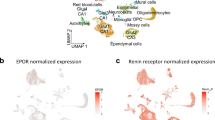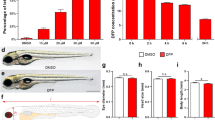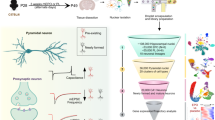Abstract
Neuropathy target esterase (NTE) is involved in neural development and is the target for neurodegeneration induced by selected organophosphorus pesticides and chemical warfare agents. We generated mice with disruptions in Nte, the gene encoding NTE. Nte−/− mice die after embryonic day 8, and Nte+/− mice have lower activity of Nte in the brain and higher mortality when exposed to the Nte-inhibiting compound ethyl octylphosphonofluoridate (EOPF) than do wild-type mice. Nte+/− and wild-type mice treated with 1 mg per kg of body weight of EOPF have elevated motor activity, showing that even minor reduction of Nte activity leads to hyperactivity. These studies show that genetic or chemical reduction of Nte activity results in a neurological phenotype of hyperactivity in mammals and indicate that EOPF toxicity occurs directly through inhibition of Nte without the requirement for Nte gain of function or aging.
This is a preview of subscription content, access via your institution
Access options
Subscribe to this journal
Receive 12 print issues and online access
$259.00 per year
only $21.58 per issue
Buy this article
- Purchase on SpringerLink
- Instant access to full article PDF
Prices may be subject to local taxes which are calculated during checkout






Similar content being viewed by others
Accession codes
Accessions
GenBank/EMBL/DDBJ
References
Karczmar, A.G. Acute and long lasting central actions of organophosphorus agents. Fundam. Appl. Toxicol. 4, S1–17 (1984).
Solberg, Y. & Belkin, M. The role of excitotoxicity in organophosphorous nerve agents central poisoning. Trends Pharmacol. Sci. 18, 183–185 (1997).
Haley, R.W. & Kurt, T.L. Self-reported exposure to neurotoxic chemical combinations in the Gulf War. A cross-sectional epidemiologic study. JAMA 277, 231–237 (1997).
Enserink, M. Gulf War illness: the battle continues. Science 291, 812–817 (2001).
Hitt, E. New investigations into Gulf War syndrome. Nat. Med. 8, 198 (2002).
Haley, R.W. et al. Evaluation of neurologic function in Gulf War veterans. A blinded case-control study. JAMA 277, 223–230 (1997).
Lotti, M. Low-level exposures to organophosphorus esters and peripheral nerve function. Muscle Nerve 25, 492–504 (2002).
Ray, D.E. & Richards, P.G. The potential for toxic effects of chronic, low-dose exposure to organophosphates. Toxicol. Lett. 120, 343–351 (2001).
Jamal, G.A. Gulf War syndrome—a model for the complexity of biological and environmental interaction with human health. Adverse Drug React. Toxicol. Rev. 17, 1–17 (1998).
Glynn, P. Neuropathy target esterase. Biochem. J. 344, 625–631 (1999).
Johnson, M.K. The primary biochemical lesion leading to the delayed neurotoxic effects of some organophosphorus esters. J. Neurochem. 23, 785–789 (1974).
Glynn, P. Neural development and neurodegeneration: two faces of neuropathy target esterase. Prog. Neurobiol. 61, 61–74 (2000).
Johnson, M.K. & Glynn, P. Neuropathy target esterase. in Handbook of Pesticide Toxicology, Vol. 2 (ed. Krieger, R.I.) 953–965 (Academic Press, San Diego, 2001).
Lush, M.J., Li, Y., Read, D.J., Willis, A.C. & Glynn, P. Neuropathy target esterase and a homologous Drosophila neurodegeneration-associated mutant protein contain a novel domain conserved from bacteria to man. Biochem. J. 332, 1–4 (1998).
Moser, M. et al. Cloning and expression of the murine sws/NTE gene. Mech. Dev. 90, 279–282 (2000).
Kretzschmar, D., Hasan, G., Sharma, S., Heisenberg, M. & Benzer, S. The swiss cheese mutant causes glial hyperwrapping and brain degeneration in Drosophila. J. Neurosci. 17, 7425–7432 (1997).
Veronesi, B., Ehrich, M., Blusztajn, J.K., Oortgiesen, M. & Durham, H. Cell culture models of interspecies selectivity to organophosphorous insecticides. Neurotoxicology 18, 283–297 (1997).
Husain, K., Vijayaraghavan, R., Pant, S.C., Raza, S.K. & Pandey, K.S. Delayed neurotoxic effect of sarin in mice after repeated inhalation exposure. J. Appl. Toxicol. 13, 143–145 (1993).
Wu, S.Y. & Casida, J.E. Subacute neurotoxicity induced in mice by potent organophosphorus neuropathy target esterase inhibitors. Toxicol. Appl. Pharmacol. 139, 195–202 (1996).
Meredith, C. & Johnson, M.K. Neuropathy target esterase: rates of turnover in vivo following covalent inhibition with phenyl di-n-pentylphosphinate. J. Neurochem. 51, 1097–1101 (1988).
Ehrich, M. & Jortner, B.S. Organophosphorous-induced delayed neuropathy. in Handbook of Pesticide Toxicology, Vol. 2 (ed. Krieger, R.I.) 987–1012 (Academic Press, San Diego, 2001).
Ehrich, M., Jortner, B.S. & Padilla, S. Relationship of neuropathy target esterase inhibition to neuropathology and ataxia in hens given organophosphorus esters. Chem. Biol. Interact. 87, 431–437 (1993).
Atkins, J. & Glynn, P. Membrane association of and critical residues in the catalytic domain of human neuropathy target esterase. J. Biol. Chem. 275, 24477–24483 (2000).
Mignery, G.A., Pikaard, C.S. & Park, W.D. Molecular characterization of the patatin multigene family of potato. Gene 62, 27–44 (1988).
Wu, S.Y. & Casida, J.E. Ethyl octylphosphonofluoridate and analogs: optimized inhibitors of neuropathy target esterase. Chem. Res. Toxicol. 8, 1070–1075 (1995).
Jamal, G.A. Neurological syndromes of organophosphorus compounds. Adverse Drug React. Toxicol. Rev. 16, 133–170 (1997).
Wilson, B.W., Henderson, J.D., Coatney, E.M., Nieberg, P.S. & Spencer, P.S. Actions of pyridostigmine and organophosphate agents on chick cells, mice, and chickens. Drug Chem. Toxicol. 25, 131–139 (2002).
Schettler, T. Toxic threats to neurologic development of children. Environ. Health Perspect. 109 Suppl 6, 813–816 (2001).
Hardell, L., Lindstrom, G. & Van Bavel, B. Is DDT exposure during fetal period and breast-feeding associated with neurological impairment? Environ. Res. 88, 141–144 (2002).
Vilanova, E., Barril, J. & Carrera, V. Biochemical properties and possible toxicological significance of various forms of NTE. Chem. Biol. Interact. 87, 369–381 (1993).
Escudero, M.A., Cespedes, M.V. & Vilanova, E. Chromatographic discrimination of soluble neuropathy target esterase isoenzymes and related phenyl valerate esterases from chicken brain, spinal cord, and sciatic nerve. J. Neurochem. 68, 2170–2176 (1997).
Tormo, N., Gimeno, J.R., Sogorb, M.A., Diaz-Alejo, N. & Vilanova, E. Soluble and particulate organophosphorus neuropathy target esterase in brain and sciatic nerve of the hen, cat, rat, and chick. J. Neurochem. 61, 2164–2168 (1993).
Akbarsha, M.A. & Sivasamy, P. Male reproductive toxicity of phosphamidon: histopathological changes in epididymis. Indian J. Exp. Biol. 36, 34–38 (1998).
Hamm, J.T., Wilson, B.W. & Hinton, D.E. Organophosphate-induced acetylcholinesterase inhibition and embryonic retinal cell necrosis in vivo in the teleost (Oryzias latipes). Neurotoxicology 19, 853–869 (1998).
Forshaw, P.J., Atkins, J., Ray, D.E. & Glynn, P. The catalytic domain of human neuropathy target esterase mediates an organophosphate-sensitive ionic conductance across liposome membranes. J. Neurochem. 79, 400–406 (2001).
van Tienhoven, M., Atkins, J., Li, Y. & Glynn, P. Human neuropathy target esterase catalyses hydrolysis of membrane lipids. J. Biol. Chem. 277, 20942–20948 (2002).
Yau, K.W. Cyclic nucleotide-gated channels: an expanding new family of ion channels. Proc. Natl. Acad. Sci. USA 91, 3481–3483 (1994).
Burgess, J.R., Stevens, L., Zhang, W. & Peck, L. Long-chain polyunsaturated fatty acids in children with attention-deficit hyperactivity disorder. Am. J. Clin. Nutr. 71, 327S–330S (2000).
Ishimatsu, M., Kidani, Y., Tsuda, A. & Akasu, T. Effects of methylphenidate on the membrane potential and current in neurons of the rat locus coeruleus. J. Neurophysiol. 87, 1206–1212 (2002).
De Bleecker, J.L., De Reuck, J.L. & Willems, J.L. Neurological aspects of organophosphate poisoning. Clin. Neurol. Neurosurg. 94, 93–103 (1992).
Randall, J.C., Yano, B.L. & Richardson, R.J. Potentiation of organophosphorus compound-induced delayed neurotoxicity (OPIDN) in the central and peripheral nervous system of the adult hen: distribution of axonal lesions. J. Toxicol. Environ. Health 51, 571–590 (1997).
Moretto, A. & Lotti, M. The relationship between isofenphos cholinergic toxicity and the development of polyneuropathy in hens and humans. Arch. Toxicol. 76, 367–375 (2002).
Casareno, R.L., Waggoner, D. & Gitlin, J.D. The copper chaperone CCS directly interacts with copper/zinc superoxide dismutase. J. Biol. Chem. 273, 23625–23628 (1998).
Ross, C.A. et al. Polyglutamine pathogenesis. Philos. Trans. R. Soc. Lond. B Biol. Sci. 354, 1005–1011 (1999).
Cavanagh, J.B. Peripheral neuropathy caused by chemical agents. CRC Crit. Rev. Toxicol. 2, 365–417 (1973).
Barlow, C. et al. Atm-deficient mice: a paradigm of ataxia telangiectasia. Cell 86, 159–171 (1996).
Deng, C., Wynshaw-Boris, A., Zhou, F., Kuo, A. & Leder, P. Fibroblast growth factor receptor 3 is a negative regulator of bone growth. Cell 84, 911–921 (1996).
Ried, T., Landes, G., Dackowski, W., Klinger, K. & Ward, D.C. Multicolor fluorescence in situ hybridization for the simultaneous detection of probe sets for chromosomes 13, 18, 21, X and Y in uncultured amniotic fluid cells. Hum. Mol. Genet. 1, 307–313 (1992).
Johnson, M.K. Improved assay of neurotoxic esterase for screening organophosphates for delayed neurotoxicity potential. Arch. Toxicol. 37, 113–115 (1977).
Ellman, G.L., Courtney, K.D., Andres Jr., V. & Featherstone, R.M. A new and rapid colorimetric determination of acetylcholinesterase activity. Biochem. Pharmacol. 7, 88–95 (1961).
Acknowledgements
The authors thank L. Garrett, J. Cheng, Y. Dayn and K-F. Lee for assistance in generating transgenic mice, D. Wangsa for assistance with cytogenetic analyses, R. Helton for animal husbandry, E. Annas for technical support and B. Cravatt and S. Heinemann for comments and experimental advice. This work was supported by the Canadian Institutes of Health Research (C.J.W.), the US National Institute of Environmental Health Sciences, the US National Institutes of Health (J.E.C), the Department of Defense (US Army Medical Research and Material Command) and the Frederick B. Rentschler Endowed Chair (C.B.).
Author information
Authors and Affiliations
Corresponding author
Ethics declarations
Competing interests
The authors declare no competing financial interests.
Rights and permissions
About this article
Cite this article
Winrow, C., Hemming, M., Allen, D. et al. Loss of neuropathy target esterase in mice links organophosphate exposure to hyperactivity. Nat Genet 33, 477–485 (2003). https://doi.org/10.1038/ng1131
Received:
Accepted:
Published:
Issue date:
DOI: https://doi.org/10.1038/ng1131
This article is cited by
-
Sex-specific differences in plasma lipid profiles are associated with Gulf War Illness
Journal of Translational Medicine (2022)
-
Metabolomic Characterization of Acute Ischemic Stroke Facilitates Metabolomic Biomarker Discovery
Applied Biochemistry and Biotechnology (2022)
-
Organophosphorus poisoning in animals and enzymatic antidotes
Environmental Science and Pollution Research (2021)
-
Does voluntary wheel running exist in Neotropical wild mammals?
acta ethologica (2021)
-
Molecular phylogeny of the yellow peach moth, Conogethes punctiferalis (Lepidoptera: Crambidae): distribution of two genetic lineages across Japan
Applied Entomology and Zoology (2020)



